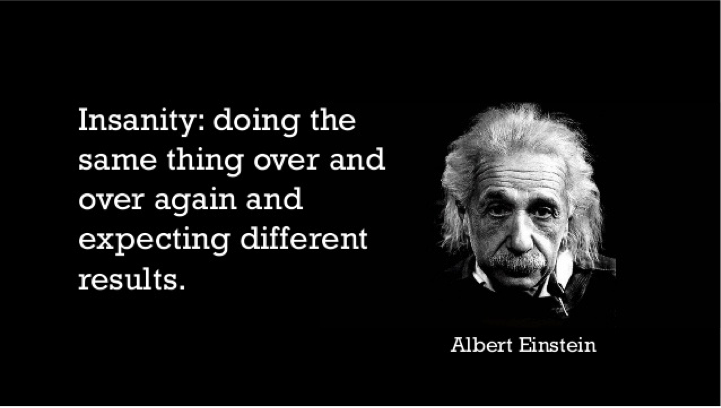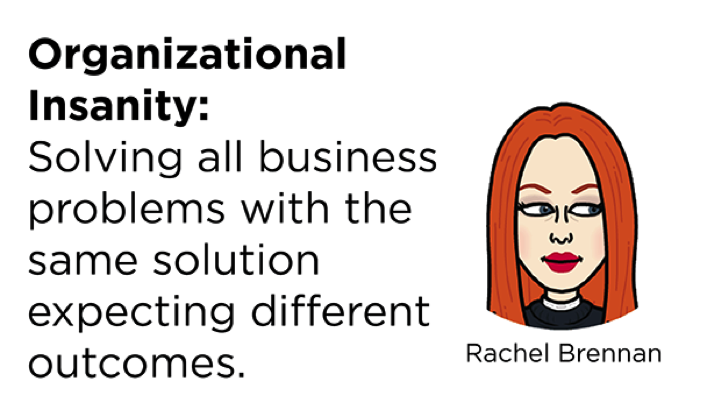Stop the Organizational Insanity
Blog: The Tibco Blog
I started 2016 out by making some process-oholic resolutions. The one I have focused on the most this year has been bringing process to the people in a consumable way, which kicked off my blog series on BPM in 5 words: process, people, context, actions, and outcomes. I have covered them a bit out of order (I couldn’t resist a good Star Wars blog), but we are now nearing the end, and it is finally time to talk about processes.
Before we get into process, I want to do a little recap of my last blog on outcomes and explain how processes and outcomes connect. Outcomes should be the heart and driving force of every process and thus are closely related. When it comes to looking at business outcomes, I like to pretend that I am a process doctor diagnosing the business, because bad business outcomes are like symptoms and the business problems are the causes. There are many different business outcomes you can aim for and even more business problems that cause those bad outcomes. Keeping up my beloved extended metaphor for just another minute—if this is the case, then a good process is the cure, and not every cure is effective on every illness or symptom.
Business outcomes range from the basic three: more revenue, less cost, and less risk—

—to more fancy-schmancy outcomes around sales effectiveness, customer satisfaction, and regulatory compliance. When you are ready to expand into the fancy-schmancy ones, a great resource to check out is Gartner’s Business Value Model. They provide information around several more advanced outcomes (see table below) and guidance on what to measure to gauge your success in that area. Process and BPM have gotten a bit of a bad reputation in the last few years (only outside of the process-oholic community, of course). They are often viewed as being legacy or old-fashioned, stifling to innovation, and too difficult and slow to change to keep up with modern businesses. This is correct—only if you aren’t aware of the full spectrum of processes. The broad variety of business outcomes has forced different styles of processes to evolve to address them.
Process and BPM have gotten a bit of a bad reputation in the last few years (only outside of the process-oholic community, of course). They are often viewed as being legacy or old-fashioned, stifling to innovation, and too difficult and slow to change to keep up with modern businesses. This is correct—only if you aren’t aware of the full spectrum of processes. The broad variety of business outcomes has forced different styles of processes to evolve to address them.
Albert Einstein is often quoted as defining insanity as, “Doing the same thing over and over again expecting different results.”

I tend to agree with him on this one, and I am personally guilty of it from time to time. I think that his definition can be extended to organizations as well and that the definition of organizational insanity is to try and solve all business problems with the same solution expecting different outcomes. It just doesn’t work, and many organizations are guilty of this behavior now and then. I believe much of process and BPM’s bad reputation stems from this. If your desire is to provide a delightful, personalized customer experience, then don’t implement a traditional process solution that focuses on cutting costs. If your desire is to optimize the outcomes of bespoke interactions, then don’t implement a traditional process solution that focuses on enforcing a single best practice (standardization).
It just doesn’t work, and many organizations are guilty of this behavior now and then. I believe much of process and BPM’s bad reputation stems from this. If your desire is to provide a delightful, personalized customer experience, then don’t implement a traditional process solution that focuses on cutting costs. If your desire is to optimize the outcomes of bespoke interactions, then don’t implement a traditional process solution that focuses on enforcing a single best practice (standardization).
There are many process styles. Some are suited for standardizing processes; some are more geared towards innovation or handling unpredictable business situations. Be sure you are using the right ones for the right business outcomes and problems.
In broad strokes, I typically categorize the different types of processes by process complexity and volume, with the left side being traditional processes and the right side contextual processes. Traditional processes are focused on standardization and efficiency, while contextual processes are all about rapid change and personalization. As businesses are starting their digital business transformations, more of their processes are going to need to be contextual to get the results they are after.
Traditional processes
Human workflow:
Simple processes that have a prescribed path and require very little external data. They are mainly used to produce an audit trail of work, track service level agreements (SLAs) or escalations. This type of process is designed to provide business visibility, traceability, and accountability.
Human and system interaction:
These processes manage the access and manipulation of data and external systems, just as much as the people and the processes. These processes tend to be focused on standardization to gain efficiencies and reduce costs.
Approval processes:
These processes can range in sophistication—from a simple approval situation like an expense report to far more sophisticated requests such as access to highly secure or classified systems that require several layers of approvals and some automation. The primary focus for these processes are compliance, but they also tend to supply traceability and accountability.
To-do lists:
A very simplistic form of process, which just tracks, and possibly assigns, tasks to individuals or groups. These processes are mainly used for work prioritization, producing audit trails, and SLA tracking.
Contextual processes
Dynamic processes:
When designing these processes, a known number of options are prepared for; the exact path isn’t chosen until the process is run and the system inspects the business data. This type of process tends to be used to achieve consistent operations across channels or geographies or to provide a personalized experience.
Rules-based processes:
These processes are a variant of dynamic processes that utilize the complex decision-making capabilities of a business rules engine (BRE) to determine the process’ path. This is only necessary when there are many data points or patterns that need to be taken into account. This type of process tends to be used to achieve consistent operations across channels, for many products/services, or to enforce better business decision making.
Case management:
Case management is a specialized type of process that enables people to manage a business object or data (the case or context) with small bits of process. This is used when the person is the main decision maker, as opposed to the system. This type of problem specializes in offering personalized experiences, getting better business outcomes from improvisational situations (e.g. a fraud investigation), and allowing people to act on their insights.
Process-based apps:
Process-based apps are process solutions that are custom tailored to address a particular business use case and user/customer experience. Since they are built on top of (or around) processes, they are quick to build and change. They allow business apps to be created in days versus months in order to enable innovation through experimentation. These processes are especially useful for improving business outcomes focused on innovation.
Event-driven processes:
These are similar to dynamic processes in that the path isn’t decided until the process is run but do not rely on just business data. With event-driven processes, different business events or moments can adjust the path of the process, give next-best suggestions, or add additional tasks or activities in real time. These processes are key to personalized experiences, working with very tight SLAs, or rapidly or constantly changing business conditions.
Predictive operations:
Predictive operations (aka intelligent business operations) require an intelligent analytics dashboard to spark actionable insights that can directly affect how processes are executing. These processes let you operate on a rapid measure-predict-optimize cycle.
Stop the organizational insanity
One of the best ways to stem the organizational insanity is to ensure you are looking at the desired business outcomes and what you would like to change before implementing a process solution. This gives you the opportunity to look for the type of process (or a combination of process types) that is going to provide your desired outcomes—instead of just trying to solve every business problem with the same traditional process.
Just like there is a right process type to do the job, there is also the right business process platform for the job. Not all business process platforms can handle all types of process. TIBCO ActiveMatrix BPM can manage your full range of processes in a single solution. Learn more here.
Leave a Comment
You must be logged in to post a comment.







